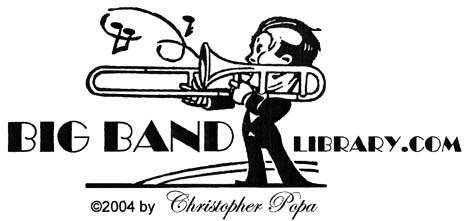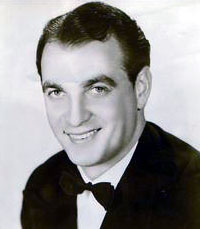
Ayres was signed to a recording contract, briefly by Variety, then for Vocalion, and, finally, on Bluebird, where he and his big band made just over 100 sides between December 1939 and July 1942.
The most famous of his records was Make-Believe Island, a top hit in 1940.
Sidemen who worked in his group included, at various times, trombonists John D'Agostino and Warren Covington; saxophonists Harry Terrill (Turetsky), Deane Kincaide and Babe Russin; drummer Joe Dale; and vocalists Mary Ann Mercer, Tommy Taylor, and Meredith Blake.
Among Ayres' compositions were the tunes I'm a Slave to You, He's a Wolf, Scratchin' the Surface, and Madeira.
vital stats:
given name Mitchell Agress
birth Dec. 24, 1910, Milwaukee, WI
death Sept. 6, 1969, Las Vegas, NV, struck by a car while crossing a street
education Columbia University, New York, NY
wife Georgiana
children two
memberships ASCAP, 1955-
hobbies golf
During World War II, Ayres began conducting for various singers including The Andrews Sisters, and, as a musical director at Columbia, led studio orchestras which accompanied Paula Kelly and The Modernaires, Buddy Clark, and Frank Sinatra on records.
Ayres joined "The Chesterfield Supper Club," a popular radio program which starred Perry Como, in late 1948. They moved into a weekly TV show in 1955.
As Como's music director, he also made many RCA Victor recordings with him, conducting on such favorites as Papa Loves Mambo, You'll Always Be My Lifetime Sweetheart, Juke Box Baby, and Magic Moments, each arranged by Joe Reisman.
Mitchell Ayres in his own words:
"Out of my original group of musicians, five remained with me most of that time . . . you can't
use men who panic when those red lights on the camera go on. It's wonderful when your
friends are good musicians as well."
"If I like a job I'll accept it first, and think about the money later."
"We need more vision, more long-range planning . . . The trouble is, ALL people in TV are
laymen when it comes to music. Look at the reviews in the trades and newspapers; all you
read about are the singers, dancers, sets, art direction, but nothing about music. Musicians
are rewarded in movies by winning Oscars. In TV they should break down the categories to
allow musicians to be acknowledged for their efforts."
Likely because of that notoriety with Como, Ayres made some new, instrumental recordings under his own name for RCA Camden in 1953 and which were released on 45 rpm extended-play discs. They were followed by a reissue LP, "Dance Time" (RCA Camden CAL-266), the only one to collect a sampling of his band's original Bluebird sides, and a new, stereo record, "Have a Wonderful Weekend" (RCA Victor LSP-1603), mostly a series of medleys, done in late 1957.
His own final album, "The Hollywood Palace" (Command RS 902-S.D.), a mixture of pop songs and standards, was released in 1966, though he led the orchestra for singer John Gary's concert at Carnegie Hall in New York, a performance which came out on RCA Victor in 1967.
At the time of his death, Ayres was in Las Vegas conducting for singer Connie Stevens, who was appearing at the Landmark Hotel.
In the mid-1970s, longtime Ayres musician Harry Terrill formed with singer Marion Herrman a reconstituted "Mitchell Ayres Orchestra" that worked in and around New York City.
sources:
"Ayres, Mitchell" in ASCAP Biographical Dictionary, Fourth Edition (New York City: Jaques
Cattell Press, 1980), p.19.
Charles Garrod, Mitchell Ayres and His Orchestra (Zephyrhills, FL: Joyce Record Club,
1991).
Paul Henniger, "Mitchell Ayres Swings in Golf, Music," Los Angeles Times, Aug. 8, 1966,
p.C28.
Roger D. Kinkle, The Complete Encyclopedia of Popular Music and Jazz 1900-1950:
Volume 2 Biographies A Through K (New Rochelle, NY: Arlington House Publishers,
1974), pp.529-530.
Procter Lippincott, "The Swing Era Swings Once More," New York Times, Dec. 23, 1979,
p.LI11.
"Mitchell Ayres Dies in Accident: 'Fashions in Music' Leader Hit by Car in Las Vegas,"
New York Times, Sept. 7, 1969, p.86.
"Mitchell Ayres Rites Set Today," Los Angeles Times, Sept. 9, 1969, p.A3.
Joel Whitburn, Billboard Pop Hits: Singles & Albums 1940-1954 (Menomonee Falls, WI:
Record Research, Inc., 2002), p.26.
I would like to expand this tribute with, if possible, a new interview of someone who was important to Mitchell Ayres' life or career. Are you an alumnus of his band, a member of his family, or a collector who is knowledgeable about his accomplishments? Please contact me via e-mail
FEEDBACK AND FOLLOW-UP
Greg Van Beek wrote to me on Oct. 18, 2008:
"Your Big Band Library website is outstanding . . . Perhaps you
already know that in 1964, after Perry Como's weekly TV series
ended (which was based in New York), Mitchell moved to Los Angeles
to become the conductor of the orchestra on the . . . ABC-TV
variety series The Hollywood Palace. The Palace was dubbed the
'West Coast Ed Sullivan Show.' Indeed it was the same vaudeville
format as the Sullivan show, with one big difference....the show
had a different celebrity host each week . . . After Mitchell's
tragic death in September 1969, Nick Perito, who replaces Ayres as
Perry Como's music director in 1964, took over the baton for the
Hollywood Palace during its final season (the series ended in
February 1970). The 1969-70 season opener was taped on September
30, 1969, just weeks after Ayres' death. Incidentally, Nick Perito
was a dear friend of mine. He passed away August 3, 2005 of
pulmonary fibrosis, just three months after contracting the
disease."
return to "Biographical Sketches" directory
go to Big Band Library homepage
The big bands are back
in a new and exciting way!
MITCHELL AYRES
"SCRATCHIN' THE SURFACE"
by Music Librarian CHRISTOPHER POPA
August 2008
Though perhaps best-known as music director for singer Perry Como, with whom he worked from 1948 to 1963, he played violin with various orchestras and got off to a good start with his own "Fashions in Music" ensemble, formed in 1937.
One of his band's first engagements was extended from four weeks to seven months, followed by appearances in such states as Texas and Ohio, and a six-month job at the Village Barn in New York City.
Portrait by Bruno of Hollywood.
